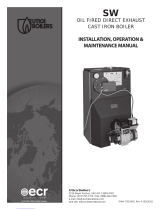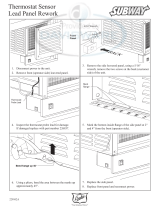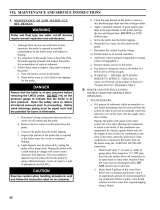
17
7. Inspect oil nozzle, electrodes and head setting.
a. Installation/Removal of Drawer Assembly
i. Loosen screws, rotate latches and swing
open the transformer.
ii. The combustion head assembly can be
removed with the blower wheel access cover
in place or removed. If the access cover is
removed, the head assembly will not have to
be rotated.
Disconnect the ared tting to the oil line
and remove the aluminum thumb-nut from
the nozzle line. Remove the combustion
head assembly from the air tube. Rotating
the assembly upside down will ease
removal.
iii. Loosen the clamp screw on the retention
ring assembly and slide the retention ring off
the adaptor.
Inspect the nozzle for size and type. See
Burner Specications, Table 12 at the rear of
this manual.
iv. Replace the retention ring assembly, slipping
one of the riveted arms through the 1/8-inch
gap between the electrode tips. This arm
should be straight up. Also, be sure that
the retention ring clamp is tight against the
shoulder on the adaptor. Then tighten the
clamping screw.
v. Check the electrode settings specied as
follows and shown in Figure 29B. 1/8-inch
gap, 1/4 to 5/16-inch above the nozzle
centerline, and ush to 1/16-inch ahead of
the nozzle tip.
vi. Re-install the combustion head assembly
holding it upside down while inserting
into the housing. The ame retention ring
end of the assembly must be lifted and
guided through the throttle cone (a reduced
diameter) in the end of the air tube. DO
NOT FORCE IT.
vii. After attaching the proper positioning bar,
refer to Paragraph 7b below, run the thumb-
nut onto the nozzle line and tighten it lightly.
Connect the ared tting on the copper oil
line to the nozzle line and tighten.
b. Combustion Head Positioning Bars
i. The Elite EZ-1HP and EZ-2HP burners are
supplied with the proper positioning bar
installed onto the housing that matches the
input oil nozzle installed in the burner.
Verify that the installed positioning bar
matches the input oil nozzle installed in the
burner, refer to Table 12 at the rear of this
manual.
In the case of the EZ-1HP, the proper head
positioning bar is still matched by the size
of the nozzle, not the input. For example, if
nozzle size is 0.75 GPH, input @ 150 psi is
approximately 0.90 GPH and the proper bar
is 0.75 GPH.
ii. Model EZ-1HP Positioning Bars: 0.50
GPH, 0.60-0.65 GPH, 0.75 GPH, 0.85-1.00
GPH, 1.10-1.25 GPH, 1.35-1.50 GPH, 1.65
GPH.
iii. Model EZ-2HP Positioning Bars: 1.50
GPH, 1.65-1.75 GPH, 2.00 GPH, 2.25 GPH.
c. Initial Air Band Setting
i. The nozzle size in GPH INPUT is printed
directly on the air band. Loosen the locking
screw, move the air band until the pointer
on the air shutter and housing lines up with
the appropriate GPH INPUT. Tighten the
locking screws.
ii. The Elite burners use calibrated air bands
marked in nozzle sizes. Models EZ-1HP
and EZ-2HP have air bands calibrated to
deliver the proper amount of air for their
specic pump pressure. The air bands on
H.P. models are designed to be set by the
rating stamped on the nozzle.
iii. The burner is now set at the approximate
air band setting for the gallonage indicated.
During nal adjustment, using combustion
testing equipment, the air band may need
minor adjustment to achieve the desired
efciency.
L. INSTALL CARLIN 102CRD OIL BURNER,
7 thru 9 Section (See Figure 7).
Follow instructions in Paragraph J, Steps 1 through 6.
7. Inspect electrodes, head setting and factory installed
oil nozzle.
a. Installation/Removal of Drawer Assembly
i. Loosen screws, rotate latches and swing
open the transformer.
Disconnect the ared tting to the oil
line and remove the aluminum thumb-
nut from the nozzle line. Remove the
combustion head assembly from the air
tube. Rotating the assembly upside down
will ease removal. Inspect the nozzle for
size and type, refer to Section XVII Burner
Specications, Table 12 at the rear of this
manual.
ii. Check the electrode settings specied as
follows and shown in Figure 29C. 1/8-inch
gap, 1/4-inch above the nozzle centerline,
and 3/16-inch ahead of the nozzle tip.
SECTION III: KNOCKDOWN BOILER ASSEMBLY (continued)
























